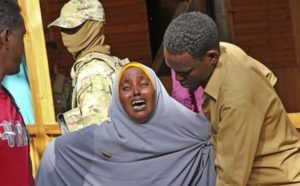By Liban Farah

In the American folktale, Brer Rabbit and the Tar Baby, the architect of the plot is Brer Fox who’s hiding in the bushes laying low and grinning ‘an evil grin,’ who’s also at the same time intentionally obscured central character by his very omission from the title. After all, it’s Brer Fox who ‘decided to capture and kill Brer Rabbit,’ who made the tar baby and chose the exact location for his clever trap; and of course, it’s Brer Fox who collected the tar, mixed it with the turpentine and sculpted into a little baby figure. Brer Rabbit fails to reflect on any of that as his mind was too distracted by the self-inflicted escalating situation as the quandary unfolds at an ever increasing spiral of full-on mad struggle.The more Brer Rabbit tries to violently lash out with angry kicks at Tar Baby, the more entangled and blinded by his rage Brer Rabbit becomes – all the while as ‘Brer Fox danced with glee behind the bushes’ barely containing his laughter at the madness he successfully orchestrated.
I felt compelled to dedicate the opening lines of above paragraph to a folktale originally passed down from generations of slaves which is to date very strongly associated with American slavery, for multitude of reasons that are uniquely applicable to the situation in Somalia. It’s up to others to deconstruct and find their own interpretations, but if we exploit the metaphor implied by the Tar Baby “problem” – a role sometimes played by tribal politics, other times by Arab states like the UAE, but most dutifully fulfilled by Al-Shabaab which is best described as an illegitimate demi creature birthed by whatever process that continues to sustain it – we can immediately see that we’re as foolish as Brer Rabbit. This piece is merely a humble attempt to draw the public attention to certain fundamental happenings obfuscated from the general psyche as to be rendered frivolous sideshow.
Security
Feel free to imagine term is ‘insecurity’ every time you read the phrase “security” in connection with Somalia, but it’s strongly recommended to entertain the thought that these words are interchangeable. Simply because all the gains, benefits and profits are derived from the insecurity in Somalia, not security. In fact, there’s a negative correlation between increasing “security” expenditure in Somalia and deteriorating overall insecurity in the country. Despite spending annually an estimated $1.5 billion on “peacekeeping, counterinsurgency and support to the Somali security sector” (ignoring associated costs for international maritime anti-piracy measures), Somalia is kept by its so-called international partners in suspended state of insecurity equilibrium. It’s a matter of fact that the $30+ billion spent directly and indirectly on security & stabilisation as the stated objectives has been an utter failure from the point of view of Somalis. Yet somehow, somewhere, billions have exchanged hands which made many nations, organisations and individuals very rich. In order to best understand this by retrieving exact figures to forensically expose some of the main beneficiaries, it’s necessary to solely focus on the funds recipient nations, and to be of comparative value, we also need to isolate a single source; Chosen here is the US economic aid recipients for reasons that’ll become evident later.
Doing so reveals that between the years 2007-2017 the United States alone gave Ethiopia $7.9b ($7,920,642,165); Kenya $7.3b ($7,322,233,305); and Uganda $5b ($5,020,678,907) as economic aid (excluding security assistance, military equipment and debt relief). This firmly places them in the top 10 recipients of US economic aid out of total 183 global recipient countries, and they happen to be AMISOM troops contributing countries. One might question the possibility that these states may’ve had received such economic aid anyway irrespective of having troops in Somalia. Well, no. Before Ethiopia troops invaded Somalia, average annual US economic aid was around $259m ($259,236,536) but this amount jumped to $720m ($720,058,379) annually after its invasion which corresponds to a 64% increase! In contrast, Somalia received just over $1b ($1,074,331,696) US economic aid over the same period of 2007-2017.
The situation is now as such, that US security aid in Somalia officially outstrips US economic aid (fig.1), nevertheless, 97% of the security aid in 2017 and 98% in 2016 was earmarked for “Peacekeeping Operations” (aka AMISOM). That equates to 93% share of US security spending in Somalia in the last 11 years.
Liban Farah
Email: [email protected]
We welcome the submission of all articles for possible publication on WardheerNews.com. WardheerNews will only consider articles sent exclusively. Please email your article today . Opinions expressed in this article are those of the author and do not necessarily reflect the views of WardheerNews.
WardheerNew’s tolerance platform is engaging with diversity of opinion, political ideology and self-expression. Tolerance is a necessary ingredient for creativity and civility.Tolerance fuels tenacity and audacity.
WardheerNews waxay tixgelin gaara siinaysaa maqaaladaha sida gaarka ah loogu soo diro ee aan lagu daabicin goobo kale. Maqaalkani wuxuu ka turjumayaa aragtida Qoraaga loomana fasiran karo tan WardheerNews.
Copyright © 2024 WardheerNews, All rights reserved


